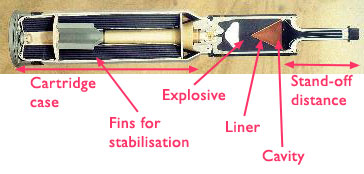
Logo from Scott Cunningham.

Logo from Scott Cunningham.
![]() ost-war developments of HEAT projectiles led to dramatic improvements in penetration. Shaped charges became the preferred warhead for anti-tank rockets, missiles and low velocity guns. Although HEAT nearly became the dominant ammunition for high velocity tank guns in the 1960s, its importance has declined since then and it is now regarded as secondary rather than primary tank gun ammunition.7
ost-war developments of HEAT projectiles led to dramatic improvements in penetration. Shaped charges became the preferred warhead for anti-tank rockets, missiles and low velocity guns. Although HEAT nearly became the dominant ammunition for high velocity tank guns in the 1960s, its importance has declined since then and it is now regarded as secondary rather than primary tank gun ammunition.7
Whereas early non-spinning shaped charges had a maximum penetration of about 4 cone diameters, shaped charges in the 1970s had a maximum penetration of 7 cone diameters, and shaped charges in the 1990s have a maximum penetration of 9 cone diameters. The main reason for the considerable increase in penetration has been improvements in the quality of the liners and the precision with which shaped charges are produced. This allows the jet to elongate further before breaking up, allowing it to increase to a higher velocity thus increasing penetration. Liners continued to be made of copper; although tantalum increases penetration even if used as a thin layer on the inner face of the copper liner, its prohibitive cost means that it is rarely used.7
Optimum stand-off distance has increased, but design considerations limit it to about 2 cone diameters in practice…
These higher penetrations are achieved by a longer jet, which means it needs more time to develop and thus for optimum penetration the stand-off distance must be increased as well, from about 2 cone diameters for early shaped charges to about 8 for modern versions. In practice the stand-off distance is severely restricted by the construction of the projectile or missile, although attempts have been made to overcome this in missiles such as the TOW by fitting them with long probes. Otherwise a restriction in the stand-off distance to about 2 cone diameters has to be accepted, but even with this restriction maximum penetration is improved to about 5 and 7 cone diameters, respectively, for 1970s and 1990s shaped charges.7
Penetration was improved for rifled HEAT ammunition by the use of slipping driving bands, first developed by Germany towards the end of World War II. These virtually eliminate spin on the projectile, thus avoiding the drastic loss of penetration caused by spin. The projectile required fins for stabilisation, but fin stabilised HEAT projectiles were never as accurate as spin stabilised HEAT projectiles.7

A modern 120mm fin stabilised HEAT–MP projectile. The blunt nose is a characteristic of such projectiles and aids stability, although it contributes to increased drag and leads to a rapid velocity loss with range. From the Military Analysis Network.
Other improvements in modern HEAT projectiles have been the use of quicker acting fuses allowing muzzle velocities to be increased, resulting in better accuracy and thus range. The increase in muzzle velocity was to about 1,200m/s, which is still lower than for other contemporary ammuniton types such as APFSDS which can be up to 1,650m/s.7
An alternative to fin stabilisation was the Gessner (German) or Obus-G (French) projectile. This projectile had a rotating outer body with a non-rotating inner body within, mounted on ball bearings and carrying the shaped charge. It is an ingenious solution, allowing the improved accuracy of spin stabilisation without its detrimental effects on penetration. One drawback is that the shaped charge is of lesser diameter because of the necessary thickness of the projectile’s body, being about 82% of the calibre. Nontheless when it was developed in the late 1950s and early 1960s its penetration of 360mm was considerably greater than that of contemporary kinetic energy armour piercing projectiles. As a result the French army adopted it as the only ammunition type for its AMX–30 main battle tanks.7
Britain did not adopt HEAT projectiles for any tank guns…
In contrast, Britain did not adopt HEAT projectiles for any of its tank guns, mainly because of doubts about their lethality. Although high penetrations can be achieved, this does not equate to damage to the target. Furthermore widespread doubts about the effectiveness of shaped charges arose during the 1970s with the development of new forms of armour, such as Chobham armour, which proved to be much more effective against shaped charges than homogenous steel. At the same time the effectiveness of kinetic energy armour piercing projectiles increased considerably with the introduction of APFSDS ammunition. As a result the relative importance of HEAT projectiles declined during the 1970s and they became to be regarded as secondary rather than primary tank gun ammunition.7
Do you like this web site? Please rate it between one and ten, with ten being the best:
Ratings are submitted to: The Wargames and Military History Search Engine.
Copyright © 2000 David Michael Honner. E-mail: GvA@wargamer.org.